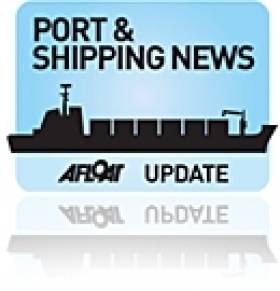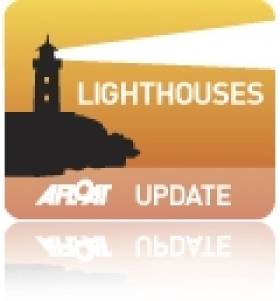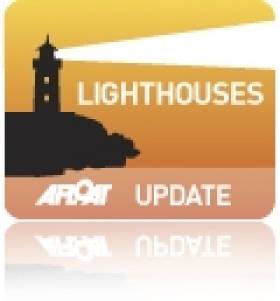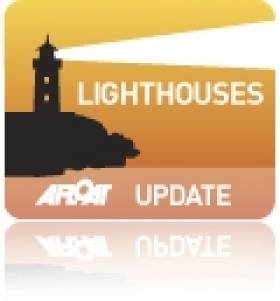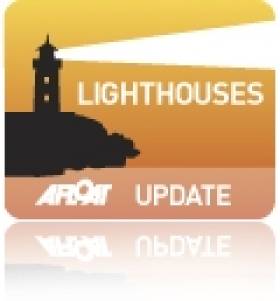Displaying items by tag: lighthouses
Ports & Shipping Review: Celtic Link Ferry 1st Year, Collision in Rosslare,Ports to Gain from Energy Sector, Volunteers for Tallship Dry-Docking and More...
#PORTS & SHIPPING REVIEW - Over the last fortnight Jehan Ashmore has reported from the shipping scene where Celtic Link Ferries celebrated their first year in service of the ro-pax ferry Celtic Horizon which operates the Rosslare-Cherbourg route.
Also in Rosslare, Stena Line's Fishguard ferry Stena Europe attempted to berth in high winds which led to the vessel making contact with the bow of Irish Ferries cruiseferry Oscar Wilde.
Further ferry news, though from Cork where last weekend saw the final end of season round-trip sailing to Roscoff operated by Brittany Ferries cruiseferry Pont-Aven.
According to the Irish Maritime Development Office (IMDO), Irish Ports are in a good position to capitalise on the growing demand for offshore renewable energy services.
Following the tallship Tenacious 'Open Day' in Dublin Port in late October, the 65m long barque returned to Dublin Bay, but instead made an overnight visit to Dun Laoghaire with 28 crew trainees on board. Her owners the Jubilee Sailing Trust are looking for volunteers to carry out tasks while she undergoes dry-dock this month.
Turnover in the Dublin Port Company has edged fractionally higher in 2011 at €69.1m and operating profit also slightly increased by €0.8m to €27.8m on 2010 figures.
An apt office location for Decisions (D4H) a software firm specialising in emergency response technology has made its new home at a building block adjacent of the Baily Lighthouse in Dublin Bay.
Software Firm Moves Into Baily Lighthouse
#LIGHTHOUSES - A software firm specialising in emergency response technology has made its new home at the Baily Lighthouse in Dublin Bay, according to The Irish Times.
The Howth Head lighthouse is the last in the State to become fully automated, and the vacancy in the adjacent offices is being filled by Decisions [D4H].
The software company was started by emergency responders who develop remote service technology for oil exploration, hazmat workers, firefighters, coastguards and more the world over.
[D4H]'s new location will house the company's engineers, customer service staff and management.
Ports & Shipping Review: EU Ports Conference, Irish Cargoship Strikes Rock, Cruise Sector, Lifeline for WWI Warship, Lightship Scrapped and more…
#PORTS & SHIPPING REVIEW - Over the last fortnight Jehan Ashmore has reported from the shipping scene, where the European Commission hosted a major ports conference on the EU policy framework for ports.
Irish Ferries won 'Best Ferry Operator' in an award held in Birmingham, which was presented by Group Leisure, a leading British travel trade publication.
A brand new Irish flagged cargoship, Huelin Dispatch (2012/2,545grt) struck a rock while on its maiden voyage from Southampton to the Channel Islands. No crew were injured and the vessel was re-floated and then proceeded to dry-dock in Falmouth.
Large cruiseship operators could be a source of funding for the proposed redevelopment of Galway Port, a Joint Oireachtas Committee on Transport and Communications has been told.
Next year cruise passengers will be able for the first time to travel directly from Ireland to Norway on a major cruiseship from Cobh operated by Royal Caribbean International.
The 98 year-old HMS Caroline, berthed in Belfast, is to be given a lifeline, after the Stormont Assembly is to allocate £100,000 for restoration work on the famous World War I warship.
An industrial dispute over crew salaries and conditions at Brittany Ferries which ran for ten days ended earlier this week and where sailings on the Cork-Roscoff route returned to service yesterday.
The former headquarters of the Commissioners for Irish Lights in Dublin 2 is for sale at €2.85 million on the instructions of Nama, which is 89% drop on the €26 m paid for the block in 2006 by Pembroke Partnership.
A report by the MCIB was published into the grounding of Arklow Raider (2007/2,999grt) at the mouth of the River Boyne in 2010, nobody was injured and no pollution occurred.
One of the last surviving Irish lightships, ALF Skua which was automated in the early 1980's, finally ended her days as work on scrapping took place on the banks of the River Avoca in Arklow.
Today marks the final day of the Open House Dublin weekend, which was organised is to make architecture more accessible to the public and free of charge. Among the events today are guided tours (first come, first served basis) of the current headquarters of the Commissioners of Irish Lights and the National Maritime Museum of Ireland also located in Dun Laoghaire. For details visit www.openhousedublin.com
Another Lightship Extinguished into History
#LIGHTSHIPS – As each day passes, quite literally chunks of Irish maritime heritage are been rapidly consigned to history, as work on scrapping the former lightship ALF Skua takes place on the North Quay in Arklow, writes Jehan Ashmore.
As the vessel lies forlornly alongside her River Avoca berth, a blowtorch cuts away in earnest at the steelwork. In tandem a crane-grabber lifts large sections of the red painted ship and loaded into an awaiting quayside truck.
What remains as of this week is only the hull, as the bridge, deckhouse structure and lantern have gone, having said that the latter structure was removed years ago.
When the lightship was towed into the port, several elected members of Arklow Town Council, with a seafaring back-round prevailed in the public body to acquire the lantern. The structure however still remains yet to be located to an appropriate site, as according to the council they have no definite plans for the lantern, though it is envisaged that it would be at least placed in a municipal location.
For decades the lightship served several stations off the Irish coastline, having been completed in 1960 by Philip & Sons of Dartmouth for the Commissioners of Irish Lights (CIL). Constructed of steel, the 134 foot lightship, cost £124,128 when launched in the Devon shipyard, though her crew were replaced when converted to an automatic light float (ALF) in 1981/82.
The vessel's designation as an ALF lasted for more than two decades until Irish Lights sold the lightship to Arklow Shipping Ltd in 2005, however she has since changed hands while moored in the Co. Wicklow port.
Nearby to where the Skua is berthed, a lantern belonging to an older lightship fleetmate, the Albratross (built 1925), was kept to form a distinctive landmark at the entrance to Arklow Marina.
With the diminishing Skua, it is believed that only two such ships survive on this island. The ALF Kittiwake (built 1959) as previously reported on Afloat.ie is in Dublin Port, however she shifted berths several months from her prominent position opposite the 02 Theatre to the jetty within Alexandra Basin, which is hidden away from general view in the working port.
The other lightship the Petrel, was built by Dublin Dockyard between 1913-15. She remains as a floating clubhouse for the Down Cruising Club in Strangford Lough, having been towed to the lough by the lighthouse tender ILV Isolda during the late 1960's.
As for the last lightship to serve, the honour was left to the ALF Gannet. She was stationed at South Rock, off Co. Down until her decommissioning in 2009 when Irish Lights replaced the lightship with a new 'Superbuoy'.
Former Irish Lights Headquarters for Sale
#PROPERTY HQ– The Irish Times reports that the Dublin based former headquarters of the Commissioners for Irish Lights are to be offered for sale at €2.85 million on the instructions of Nama – a 89 per cent per cent drop on the €26 million paid for the block in 2006 by Pembroke Partnership.
Wesley Rothwell of CBRE says the building, (located on 16-19 Pembroke Street in Dublin 2), has not been occupied since it was sold, is now in need of extensive refurbishment.
The property became redundant when the Commissioners relocated in 2008 to a brand new custom-built HQ on the waterfront within Dun Laoghaire Harbour. As previously reported on Afloat.ie, the distinctive landmark building is to be open to the public next Sunday as part of the Open House Dublin Weekend.
Irish Lights Headquarters to Open to the Public
#OPEN HOUSE- The Commissioners of Irish Lights headquarters in Dun Laoghaire Harbour is to be made open to the public with tours on Sunday (7 October) as part of the annual Open House Weekend, writes Jehan Ashmore.
The iconic landmark building which incoporates innovative technological features is located on the waterfront within the harbour, and in which integrates seamlessly into its marine environment. The Commissioners are a General Lighthouse Authority (GLA) that is responsible for all aids to navigation around the coast of Ireland.
To enable the authority to carry out these functions, the building has an administration block and adjoining marine workshop depot. Adjacent to the facility is a berth where the ILV Granuaile (2000/2,625grt) can moor alongside to load and unload these aids to navigation. The tours will provide a fascinating insight into the work of the commissioners.
For further details and how to book a tour, plus a list of other buildings available to access and more click this LINK.
Open House Dublin is an initiative of The Irish Architecture Foundation which has an established network and track record in delivering major projects primarily aimed at developing audiences for architecture in Ireland. The foundation is also involved in raising the profile of Irish architecture abroad.
Loop Head Lighthouse To Open On Weekends During September
Clare County Council has announced that Loop Head Lighthouse will remain open to members of the public each weekend during the month of September.
The extension of the opening period follows on from a successful summer season that has seen 15,870 people (12,034 adults, 3,836 children) visit the 19th century landmark building.
Clare County Council, along with Shannon Development, Loop Head Tourism and the Commissioners of Irish Lights (CIL), opened the 19th century lighthouse to the public for the second successive summer season on 18 May last.
According to Ger Dollard, Director of Services, Clare County Council: "Loop Head Lighthouse will close at 5.30 p.m. on 3rd September next. However, we are delighted to be able to open the lighthouse each weekend during September up to the final weekend, which coincides with the Che do Bheatha festival in Kilkee. Opening hours each Saturday and Sunday during September will remain the same as the summer opening hours."
"The lighthouse visitor numbers are extremely encouraging and we look forward to building on this during September," Mr. Dollard added.
Loop Head Lighthouse, located at the mouth of the Shannon Estuary, is steeped in history and rich in maritime heritage with its origins dating back to the 1670s. The existing tower style lighthouse was constructed in 1854 and was operated and maintained by a keeper who lived within the lighthouse compound.
Taoiseach Enda Kenny's grandfather was a keeper at the lighthouse. James John McGinley took up duty at the Lighthouse as Principal Keeper on 16th January 1933. He spent 1 year and 10 months at Loop Head. He was transferred from the station in October 1934. In January 1991, the lighthouse was converted to automatic operation, and today is in the care of an attendant and is also monitored by the CIL.
Shields Leads New Era for Commissioners of Irish Lights
#LIGHTHOUSES - Making strides in renewable energy and working in harmony with the country's marine resources are top of the agenda for the Commissioners of Irish Lights (CIL) under new chief executive Yvonne Shields.
Though its main focus will remain safety at sea through its maintenance of Ireland's coastal network of lighthouses, buoys and shipping aids, Shields tells Lorna Siggins in today's Irish Times that the agency must transform in order to pay its own way - by branching out into data and information provision for fish farms and offshore wind farms, among other services.
The 'Twitter buoy' installed in Galway for the Volvo Ocean Race finale, as previously reported on Afloat.ie, is one response to the changing face of navigation, "using next generation technologies to communicate with sea goers and navigators around our coasts".
Shields' background in the Marine Institute matches her own personal interest in the economic potential of Ireland's marine sector.
“We have 10 times our land mass out there, but it only fuels 1 per cent of gross domestic product (GDP),” she says. “There’s no reason this couldn’t increase to 5 per cent and further."
Another aspect of the agency's work is co-operation with local stakeholders around the coast, such as with the RPSB on a puffin sanctuary on Rathlin Island, and a new attitude towards exploiting Ireland's lighthouse assets as tourism destinations.
The Irish Times has much more on the story HERE.
Loop Head Lighthouse Will Open To Public in 2012
#LIGHTHOUSES - Loop Head Lighthouse in Co Clare, is set to re-open to the public later this year following a successful trial scheme last summer.
As The Irish Times reports, Clare County Council opened the lighthouse for an 11-week trial period last July with the support of the Commissioners of Irish Lights, Shannon Development and Loop Head Tourism.
Some 17,000 people took up the invitation to visit the 23-metre beacon, which is still in use as a navigational aid, as previously reported on Afloat.ie.
The consortium is now looking for consultants to help expand tourism the facility with an exhibition and interpretation plan.
Marine Escapes Cuts in Latest Budget
#BUDGET - Coastguard and lifeboat services, mountain rescue and the Commissioners of Irish Lights will not face any further funding cuts in the latest Budget, according to the Minister for Transport.
The Irish Times reports that, following the reduction of his department's budget, Minister Leo Varakdar stated that substantial cuts have already occurred in the maritime safety sector.
Moreover, he announced an increase in the maritime budget from €70.5 million to €80.3 million, due to provisions for the new Irish Coast Guard helicopter contract.
Earlier this week, Minister for Agriculture, Food and the Marine, Simon Coveney, underlined the importance of the marine sector to Ireland's coastal communities.
As previously reported on Afloat.ie, Minister Coveney announced a round of expenditure estimates on Monday which include increased funding for investment in processing, aquaculture and fishery harbours.


























